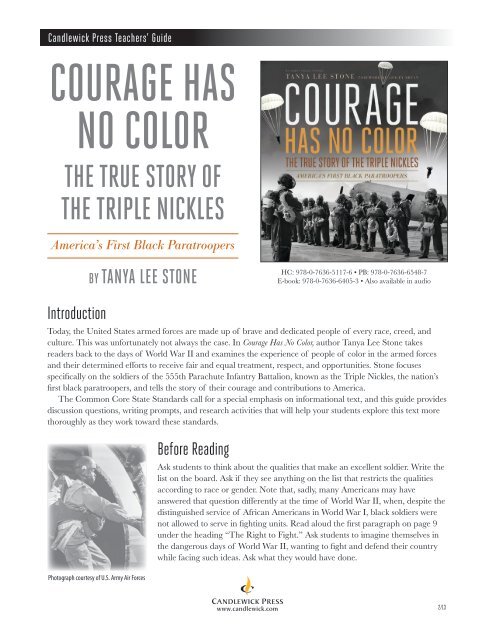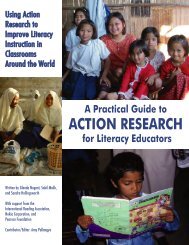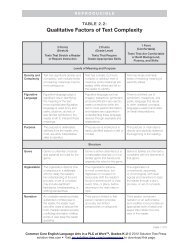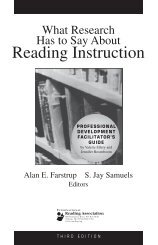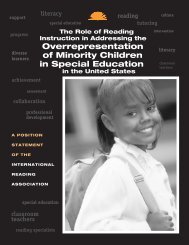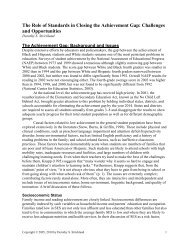Candlewick Press Teachers' Guide ⢠Courage Has No Color
Candlewick Press Teachers' Guide ⢠Courage Has No Color
Candlewick Press Teachers' Guide ⢠Courage Has No Color
Create successful ePaper yourself
Turn your PDF publications into a flip-book with our unique Google optimized e-Paper software.
<strong>Candlewick</strong> <strong>Press</strong> Teachers’ <strong>Guide</strong><br />
COURAGE HAS<br />
NO COLOR<br />
THE TRUE STORY OF<br />
THE TRIPLE NICKLES<br />
America’s First Black Paratroopers<br />
BY TANYA LEE STONE<br />
HC: 978-0-7636-5117-6 • PB: 978-0-7636-6548-7<br />
E-book: 978-0-7636-6405-3 • Also available in audio<br />
Introduction<br />
Today, the United States armed forces are made up of brave and dedicated people of every race, creed, and<br />
culture. This was unfortunately not always the case. In <strong>Courage</strong> <strong>Has</strong> <strong>No</strong> <strong>Color</strong>, author Tanya Lee Stone takes<br />
readers back to the days of World War II and examines the experience of people of color in the armed forces<br />
and their determined efforts to receive fair and equal treatment, respect, and opportunities. Stone focuses<br />
specifically on the soldiers of the 555th Parachute Infantry Battalion, known as the Triple Nickles, the nation’s<br />
first black paratroopers, and tells the story of their courage and contributions to America.<br />
The Common Core State Standards call for a special emphasis on informational text, and this guide provides<br />
discussion questions, writing prompts, and research activities that will help your students explore this text more<br />
thoroughly as they work toward these standards.<br />
Photograph courtesy of U.S. Army Air Forces<br />
Before Reading<br />
Ask students to think about the qualities that make an excellent soldier. Write the<br />
list on the board. Ask if they see anything on the list that restricts the qualities<br />
according to race or gender. <strong>No</strong>te that, sadly, many Americans may have<br />
answered that question differently at the time of World War II, when, despite the<br />
distinguished service of African Americans in World War I, black soldiers were<br />
not allowed to serve in fighting units. Read aloud the first paragraph on page 9<br />
under the heading “The Right to Fight.” Ask students to imagine themselves in<br />
the dangerous days of World War II, wanting to fight and defend their country<br />
while facing such ideas. Ask what they would have done.<br />
2/13
Discussion Questions<br />
1. Colonel Howard Donovan Queen, commanding officer of the all-black 366th Regiment of the 92nd Infantry<br />
Division in World War II, is quoted as saying, “World War I [had been] one big racial problem for the Negro<br />
soldier. World War II was a racial nightmare. . . . The Negro soldier’s first taste of warfare in World War II<br />
was on Army posts right here in his own country. This in its turn caused considerable confusion in the minds<br />
of the draftees as to who the enemy really was” (page 10). What does Colonel Queen mean by that statement?<br />
What led him to believe that?<br />
2. An amendment to the Selective Training and Service Bill stated that, “there should be no discrimination<br />
in either the selection or training of men” (page 11). Yet in 1940, President Roosevelt issued a press release<br />
saying that desegregating the armed forces “would produce situations destructive to morale and detrimental<br />
to the preparation for national defense” (page 11). Why did Roosevelt, who worked for racial equality, make<br />
such a statement? Was the amendment to the Selective Service Bill followed by the armed forces? How were<br />
black troops utilized at the beginning of World War II?<br />
3. Bradley Biggs, one of the officers of the 555th, recounts advice given to him by Colonel Benjamin O. Davis<br />
Sr., the highest-ranking black officer in the army: “Curb your tongue [and] quiet your temper. . . . Your anger<br />
will ruin your hopes for a military career. More opportunities will come to our soldiers but we must be ready<br />
for them” (page 44). Why did Davis give this advice even when Bigg’s treatment had been so unfair? Do you<br />
think that advice is relevant today?<br />
4. After training so intensely for combat, the Triple Nickles were sent west to be smokejumpers. Do you think<br />
their mission was important? Explain.<br />
5. Tanya Lee Stone points out that many photographs showing black units were left out of the record. On<br />
page 63, former corporal Charles Sprowl of the 490th Port Battalion asks, “Where were we in The Longest Day<br />
or Saving Private Ryan? Where were we in the history books?” Today, efforts are being made to recognize and<br />
honor black veterans of World War II. Is this important? Why or why not? What should be done?<br />
Writing Prompts and Research Activities<br />
with Common Core Connections<br />
1. CCSS.ELA-Literacy.RI.7.1 Cite several pieces of textual evidence<br />
to support analysis of what the text says explicitly as well as<br />
inferences drawn from the text.<br />
The men of the 555th and other black units risked<br />
their lives to serve their country in spite of pervasive<br />
racial discrimination. Why were these men willing to<br />
sacrifice so much? Cite text as evidence.<br />
Photograph courtesy of U.S. Army Air Forces<br />
2. CCSS.ELA-Literacy.W.7.1 Write arguments to support claims with clear reasons and relevant evidence.<br />
Walter Morris, an officer of the 555th, says, “It is up to me and many, many people of all races and cultures to<br />
fight the haters and racists to make this a better place to live” (page 93). Do you think the efforts of Morris and<br />
the other brave men of color who fought in World War II made a difference? Write a three-paragraph essay<br />
explaining your position.<br />
<strong>Candlewick</strong> <strong>Press</strong> Teachers’ <strong>Guide</strong> • <strong>Courage</strong> <strong>Has</strong> <strong>No</strong> <strong>Color</strong> page 2
3. CCSS.ELA-Literacy.W.7.8 Gather relevant information from multiple print and digital sources, using search terms effectively; assess<br />
the credibility and accuracy of each source; and quote or paraphrase the data and conclusions of others while avoiding plagiarism<br />
and following a standard format for citation.<br />
Examine the examples of stereotypes in early movies and advertising on pages 14 and 15 of the book. In<br />
the evening, watch ten to fifteen minutes of advertising on television and use the Internet to find advertising<br />
images for products or current movies. Compare the contemporary advertising to that shown in the book.<br />
Does the advertising in both time periods reflect actual social conditions? Why or why not? Support your<br />
conclusions with examples and cite the sources.<br />
4. CCSS.ELA-Literacy.RH.6-8.2 Determine the central ideas or information of a primary or secondary source; provide an accurate<br />
summary of the source distinct from prior knowledge or opinions.<br />
Summarize the information and events that led to the Triple Nickles’ becoming smokejumpers.<br />
5. CCSS.ELA-Literacy.RH.6-8.6 Identify aspects of a text that reveal an author’s point of view or purpose (e.g., loaded language,<br />
inclusion or avoidance of particular facts).<br />
Do you think author Tanya Lee Stone has a specific point of view on the role of the 555th in our history?<br />
Cite specific evidence. Do you agree with her position or disagree? Explain.<br />
6. CCSS.ELA-Literacy.RH.6-8.2 Determine the central ideas or information of a primary or secondary source; provide an accurate<br />
summary of the source distinct from prior knowledge or opinions.<br />
CCSS.ELA-Literacy.W.7.7 Conduct short research projects to answer a question, drawing on several sources and generating additional<br />
related, focused questions for further research and investigation.<br />
CCSS.ELA-Literacy.W.7.8 Gather relevant information from multiple print and digital sources, using search terms effectively; assess<br />
the credibility and accuracy of each source; and quote or paraphrase the data and conclusions of others while avoiding plagiarism<br />
and following a standard format for citation.<br />
Both the Tuskegee Airmen (pages 27–29) and the 442nd Regimental Combat Team (page 70) were highly<br />
decorated units made up of minority servicemen. Choose one of these units and find more information about<br />
it. Did its members experience the same obstacles to service as the men of the 555th? Write a summary of<br />
what you learn, citing your sources.<br />
Photograph: National Archives (342-FH-3B-42508-29999ac)<br />
7. CCSS.ELA-Literacy.W.7.9a Apply grade 7 Reading standards to<br />
literature (e.g.,“Compare and contrast a fictional portrayal of a<br />
time, place, or character and a historical account of the same<br />
period as a means of understanding how authors of fiction use or<br />
alter history”).<br />
Ask your school or public librarian to help you find a<br />
fictional book about a minority soldier in World War II.<br />
Compare and contrast the account in the fictional book<br />
to that presented in <strong>Courage</strong> <strong>Has</strong> <strong>No</strong> <strong>Color</strong>. Do the accounts<br />
present similar, different, or conflicting information? Cite<br />
examples. If the accounts differ, which do you believe is<br />
more accurate and why?<br />
<strong>Candlewick</strong> <strong>Press</strong> Teachers’ <strong>Guide</strong> • <strong>Courage</strong> <strong>Has</strong> <strong>No</strong> <strong>Color</strong> page 3
8. CCSS.ELA-Literacy.W.7.3 Write narratives to develop real or imagined experiences or events using effective technique, relevant<br />
descriptive details, and well-structured event sequences.<br />
Imagine it is 1944 and you are a young black man facing the draft. One of your friends asks, “Why should I<br />
die for a country that doesn’t even trust me to train with real bullets and treats me like a second-class citizen?”<br />
Another says, “It’s our duty to fight for our country too.” Describe the situation. Write about how you would<br />
feel and what you would want to do. What would you tell your friends?<br />
Photograph by Ambient Photography<br />
About Tanya Lee Stone<br />
The author of more than ninety books for young readers, Tanya Lee Stone graduated from<br />
Oberlin College, worked as an editor of nonfiction books, and earned a master’s degree in<br />
science education. She moved to Vermont, wrote her first book, and has been writing ever<br />
since. Tanya Lee Stone has received many awards, including a Boston Globe–Horn Book Honor,<br />
a Robert F. Sibert Medal, an Orbis Pictus Honor, a Jane Addams Honor, and Flora Stieglitz<br />
Straus Award; she was also named a YALSA <strong>No</strong>nfiction Finalist. She loves Crazy Core<br />
Skittles, chocolate-covered pretzels, the sounds of an orchestra warming up, and winter.<br />
Also by Tanya Lee Stone:<br />
Almost Astronauts: 13 Women Who Dared to Dream<br />
The story of thirteen women who proved that they were not only as tough as any man but<br />
also brave enough to challenge the government for the right to be part of the space program.<br />
In doing so they defied the prejudices of the time and blazed a trail for generations of women<br />
to follow.<br />
HC: 978-0-7636-3611-1<br />
PB: 978-0-7636-4502-1<br />
E-book: 978-0-7636-5609-6<br />
★ “Meticulously researched and thrillingly told.” — The Horn Book (starred review)<br />
★ “Fascinating. . . . Will leave readers inspired.” — Kirkus Reviews (starred review)<br />
★ “Passionately written.” — School Library Journal (starred review)<br />
• A Robert F. Sibert Medal Winner<br />
• A Boston Globe–Horn Book Honor Winner<br />
• An Orbis Pictus Honor Book<br />
• An American Library Association <strong>No</strong>table<br />
Children’s Book<br />
• A YALSA Award for Excellence in <strong>No</strong>nfiction for<br />
Young Adult Finalist<br />
• A National Council for the Social Studies<br />
<strong>No</strong>table Trade Book for Young People<br />
• A National Science Teachers Association<br />
Outstanding Science Trade Book for Children<br />
• A Chicago Public Library Best Book<br />
• A Flora Stieglitz Straus Award Winner<br />
• A Jane Addams Children’s Book Award Winner<br />
• A Cooperative Children’s Book Center Choices<br />
List Selection<br />
• A Kirkus Reviews Best Teen Book of the Year<br />
• A Smithsonian <strong>No</strong>table Book for Children<br />
This teachers’ guide was written by Lynn Rutan, retired middle school librarian and blogger for Bookends.<br />
<strong>Candlewick</strong> <strong>Press</strong> Teachers’ <strong>Guide</strong> • <strong>Courage</strong> <strong>Has</strong> <strong>No</strong> <strong>Color</strong> page 4


